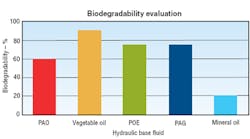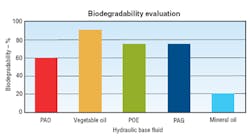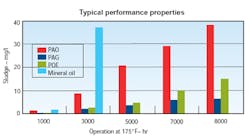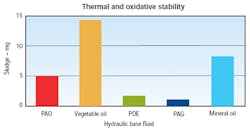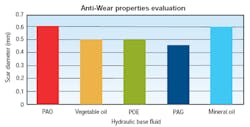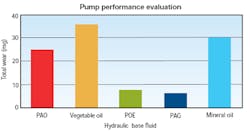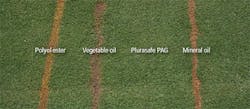Going green without failure
Specifications for hydraulic fluids abound. Some, such as viscosity or viscosity index, are important for any application. Others are more specific to the application or equipment involved, such as seal compatibility, maximum fluid change out intervals, or need for oil or water solubility. Today, however, biodegradability and aquatic toxicity have become primary considerations when selecting a hydraulic fluid.1
A wide variety of different base stocks may have these attributes, but these properties may not be relevant if the hydraulic fluid does not fulfill operating or use criteria. This is because hydraulic fluids must also:
• support equipment operation at the required pressures and temperatures, which can exceed 5000 psi and 100° C,
• exhibit high corrosion and wear resistance,
• maintain fire resistance,
• tolerate harsh environments,
• maximize change out intervals, and
• extend the life of components.
Concern is growing over the impact of lost petroleum-based and non-biodegradable fluids. A conservative estimate is that more than 600 million gal of fluids from hydraulic systems are lost each year. These are mainly from leaks, accidents, or irresponsibly spilled fluid. All hydraulic fluid spills are reportable events, which involve major cleanup and disposal costs. In most industrial plants, procedures exist to address spills with specific recovery plans in place.
However, for mobile equipment, marine environments, and other situations where hydraulic systems operate outdoors, recovery plans may not be practical; and many times, spills may go unnoticed. It is in these situations that products that are biodegradable and have low aquatic toxicity are required. This is especially true in water sensitive areas or where functional or decorative vegetation is a concern. Some examples of these applications include:
• marine and dredging machinery,
• turf and lawn equipment,
• mobile lift and construction equipment,
• submersible pumps, and
• amusement park equipment.
Fluids used in these applications need to pass biodegradation testing and, in some cases, aquatic toxicity testing. These fluids are manufactured using some type of synthetic base stock, such as polyalkylene glycols (PAG), polyol esters (POE) or diesters, or some grades of polyalphaolefins (PAO). Mineral or petroleum based oils are not biodegradable, but oils based on plant seeds, such as rapeseeds or soybeans, are biodegradable.
But not all biodegradable hydraulic fluids are the same — biodegradability does not necessarily mean not harmful to plants or vegetation. Only polyalkylene glycol based hydraulic fluids (used as recommended by equipment manufacturers) have demonstrated minimal or no harm to plants or vegetation, which is critical in sensitive applications.
As shown in Figure 1, many synthetic base stock chemistries have excellent biodegradation. They also have low aquatic toxicity, as measured by OECD 203. However, some do not meet the high performance standards that may be required of hydraulic fluid.
Synthetic based hydraulic fluids that provide the high level of performance necessary for today’s hydraulic systems achieve maximum dependability and minimum maintenance when operating at high temperatures and pressures. Because of these properties, equipment may be run longer, harder and faster, eliminating the need for the purchase or rental of additional equipment to complete jobs.
Synthetic based fluids also have a longer life than traditional mineral oil based products and have a significantly longer life than vegetable oil based products. This allows operators to use equipment for a longer period of time before a hydraulic fluid change becomes necessary. In addition, synthetics can extend equipment life. They form minimal or no sludge or varnish as do other classes of fluids such as mineral or vegetable oil as shown in Figure 2.
If an operator changed from a mineral or vegetable oil to, say, a PAG, the synthetic fluid would actually clean out sludge and contaminants left behind by these types of fluid. However, any change out from one class of fluid to another must be done under specific changeover instructions.
Other synthetic product benefits are illustrated in Figures 3, 4, and 5. Because equipment using synthetics can require fewer fluid changes, and have longer lifetimes, synthetic based fluids can also produce cost savings as well as give specific benefits for environmentally sensitive applications.
Reviewing test results
Figure 3 summarizes test results on commercially available lubricant base stocks tested according to ASTM method D 2070 wherein a beaker containing the test oil and copper and iron rods is placed in an aluminum block in an oven at 275° F for the duration of the test. At the test completion the iron and steel rods are rated visually for discoloration, and the oil is analyzed for quantity of sludge. Sludge or residue formation in this test is an indicator of thermal degradation of the test oil from oxidation.
Anti-wear performance is measured by Four-Ball Wear Test according to ASTM D-4172. Three stainless steel balls are placed in a test cell and covered with the test oil. A fourth ball is placed on top of the three through a chuck and rotated at 1800 rpm for 1 hr. Temperature of the test cell is maintained at 75° C during the test. After the test, the three steel balls are inspected through a suitable microscope for wear scars. Lower scar diameter is an indication of better anti-wear performance. Figure 4 describes the anti-wear performance of fluids in a Four-Ball Wear Test.
Pump testing according to ASTM D-7043 is an important tool for evaluating hydraulic fluid performance. The test is generally conducted at a pressure of 2000 psi and a temperature of 150° F for 100 hr. Products formulated with different base stocks give results indicated in Figure 5.
Specific products formulated from synthetic base stocks or vegetable oil for turf and lawn equipment applications may be promoted as not causing harm grass if spilled or leaked. Development of these biodegradable fluids has helped golf courses and athletic fields end turf replacement due to hydraulic line failures or accidental spills. However, only PAG based hydraulic fluids used at typical levels do not burn or kill grass.
This property is exhibited in a wide variety of grass species and, importantly, does not depend on the fluid temperature range typical for this equipment. As shown in Figure 6, PAG based hydraulic fluid used at typical levels does not burn or kill grass if spilled, regardless if the fluid is cold or hot.
Because some synthetic based hydraulic fluids are readily biodegradable, have low aquatic toxicity, can be water soluble, and reach high pressures, this makes them ideal for a wide variety of marine and port applications, where concern of water contamination from mineral or vegetable oil lubricant slicks on the surface of the water is high. Equally important to equipment operators is how well the synthetic based hydraulic fluid performs.
Criteria for biodegradable lubricants continue to expand. These properties need not preclude superior performance attributes that operating users require. The use of products based on specific synthetic functional fluids allows the operator superior biodegradability properties paired with superior performance results.
For more information, contact the author at (973) 245-6120, or e-mail visit www.basf.com.
1Biodegradation test is OECD 301 B, also known as the Sturm Test for measuring if products are readily biodegradable. Aquatic toxicity test is Method is OECD; 1992 Fish, Acute Toxicity Test. OECD Guidelines for testing of Chemicals, Section 2: Effects on Biotic Systems. Test method OECD 203.
